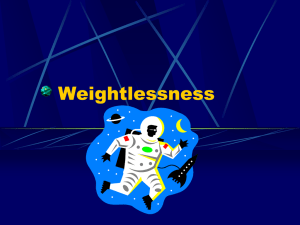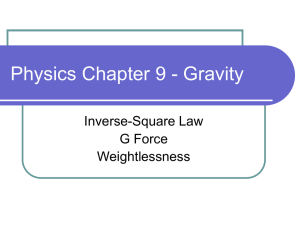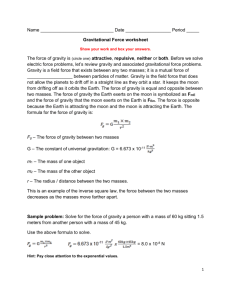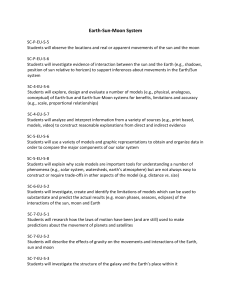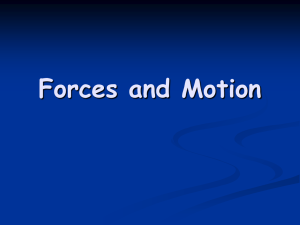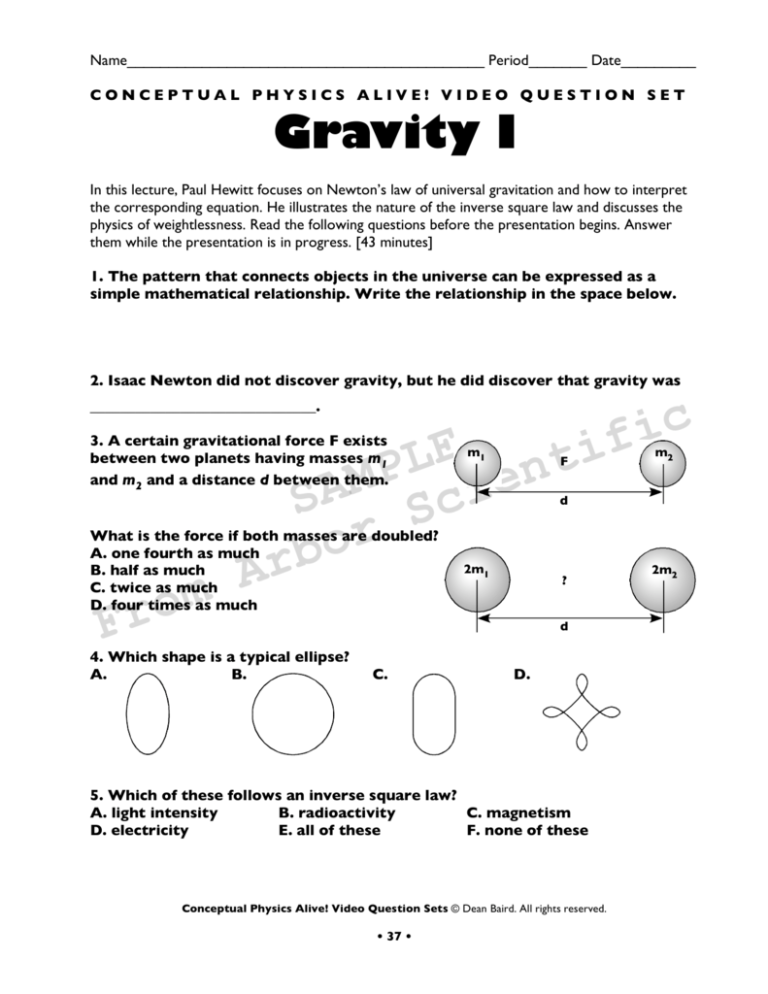
Name___________________________________________ Period_______ Date_________
CONCEPTUAL PHYSICS ALIVE! VIDEO QUESTION SET
Gravity I
In this lecture, Paul Hewitt focuses on Newton’s law of universal gravitation and how to interpret
the corresponding equation. He illustrates the nature of the inverse square law and discusses the
physics of weightlessness. Read the following questions before the presentation begins. Answer
them while the presentation is in progress. [43 minutes]
1. The pattern that connects objects in the universe can be expressed as a
simple mathematical relationship. Write the relationship in the space below.
2. Isaac Newton did not discover gravity, but he did discover that gravity was
______________________________.
3. A certain gravitational force F exists
between two planets having masses m1
and m2 and a distance d between them.
c
i
if
E
L
t
P
n
M
e
A
i
S
c
S
r
o
b
r
A
m1
F
m2
d
What is the force if both masses are doubled?
A. one fourth as much
B. half as much
C. twice as much
D. four times as much
m
o
Fr
4. Which shape is a typical ellipse?
A.
B.
2m1
?
d
C.
D.
5. Which of these follows an inverse square law?
A. light intensity
B. radioactivity
C. magnetism
D. electricity
E. all of these
F. none of these
Conceptual Physics Alive! Video Question Sets © Dean Baird. All rights reserved.
• 37 •
2m2
6. A blackboard eraser placed a certain distance from a candle casts a shadow.
How many erasers will fit into the space of the shadow at twice the distance
from the candle?
A. 1
B. 2
C. 3
D. 4
E. 6
F. 8
G. 9
7. Take your mass, multiply it by the mass of the world, divide it by the
distance between you and the center of the world squared, and you’ll get your
___________________________.
8. A person in free fall experiences a sensation that physicists call
A. true weightlessness.
B. gravitational weightlessness.
C. zero weightlessness.
D. apparent weightlessness.
9. At what distance from Earth would the Earth’s gravitational pull go to zero?
A. beyond the Earth’s atmosphere
B. beyond the sun
C. beyond the solar system
D. beyond the galaxy
E. Actually, the Earth pulls on you no matter how far you go.
c
i
if
E
L
t
P
n
M
e
A
i
S
c
S
r
o
b
r
A
10. Your weight at the top of a mountain is different because
A. the additional mass of the mountain pulls on you.
B. the additional distance weakens the gravitational force.
C. Actually, the effects of A and B result in no difference in weight.
11. A girls weighs 400 N at the surface of the Earth.
At the top of a ladder whose height is equal to the
m
o
r
radius of the Earth, her weight is __________ N.
F
?
R
400 N
12. French and German astronomers used
observations of perturbations of Uranus’ orbit to
R
locate ______________________________.
13. The most skilled skaters are those who
A. never fall down—they demonstrate superior equilibrium and caution.
B. fall down often—they’re always trying new tricks.
C. who have never skated but have memorized all the equations for skating.
14. The difference between the center of mass and the center of gravity for the
moon results in a torque that
A. aligns the moon to the Earth.
B. keeps the moon wobbling in its orbit.
C. aligns the Earth to the moon.
D. keeps the Earth wobbling in its orbit.
Conceptual Physics Alive! Video Question Sets © Dean Baird. All rights reserved.
• 38 •
Name___________________________________________ Period_______ Date_________
CONCEPTUAL PHYSICS ALIVE! VIDEO QUESTION SET
Gravity I
In this lecture, Paul Hewitt focuses on Newton’s law of universal gravitation and how to interpret
the corresponding equation. He illustrates the nature of the inverse square law and discusses the
physics of weightlessness. Read the following questions before the presentation begins. Answer
them while the presentation is in progress. [43 minutes]
1. The pattern that connects objects in the universe can be expressed as a
simple mathematical relationship. Write the relationship in the space below.
2. Isaac Newton did not discover gravity, but he did discover that gravity was
______________________________.
3. A certain gravitational force F exists
between two planets having masses m1
and m2 and a distance d between them.
E
L
t
P
n
M
e
A
i
S
c
S
r
o
b
r
A
What is the force if the distance is doubled?
A. one fourth as much
B. half as much
m1
C. twice as much
D. four times as much
m
o
Fr
c
i
if
m1
F
d
?
2d
4. Kepler discovered that planets travel around the sun in
A. circles.
B. ellipses.
C. ovals.
D. epicycles.
5. Which of these follows an inverse square law?
A. light intensity
B. radioactivity
C. magnetism
D. electricity
E. all of these
F. none of these
Conceptual Physics Alive! Video Question Sets © Dean Baird. All rights reserved.
• 39 •
m2
m2
6. A blackboard eraser placed a certain distance from a candle casts a shadow.
How many erasers will fit into the space of the shadow at three times the
distance from the candle?
A. 1
B. 2
C. 3
D. 4
E. 6
F. 8
G. 9
7. Your weight is a gravitational interaction between the ____________________
that makes you up and the __________________ that makes up the world.
8. A person in free fall experiences a sensation that physicists call
A. true weightlessness.
B. gravitational weightlessness.
C. zero weightlessness.
D. apparent weightlessness.
9. Since astronauts experience the queasy sensation of free fall all the time
they’re in orbit, they bring ____________________ ____________________ with them.
10. At the top of a mountain—strictly speaking—you weigh
A. a little bit more.
B. a little bit less.
c
i
if
E
L
t
P
n
M
e
A
i
S
c
S
r
o
b
r
A
11. A girls weighs 400 N at the surface of the Earth.
At the top of a ladder whose height is equal to the
radius of the Earth, her weight is __________ N.
C. the same.
?
400 N
12. Dwarf planet, Pluto, was
m
o
Fr
R
R
______________________________ before it was
discovered.
13. The most skilled skaters are those who
A. never fall down—they demonstrate superior equilibrium and caution.
B. fall down often—they’re always trying new tricks.
C. who have never skated but have memorized all the equations for skating.
14. The difference between the center of mass and the center of gravity for the
moon results in a torque that
A. aligns the moon to the Earth.
B. keeps the moon wobbling in its orbit.
C. aligns the Earth to the moon.
D. keeps the Earth wobbling in its orbit.
Conceptual Physics Alive! Video Question Sets © Dean Baird. All rights reserved.
• 40 •
Instructor’s Answer Key
Name___________________________________________
Period_______ Date_________
CONCEPTUAL PHYSICS ALIVE! VIDEO QUESTION SET
Gravity I
In this lecture, Paul Hewitt focuses on Newton’s law of universal gravitation and how to interpret
the corresponding equation. He illustrates the nature of the inverse square law and discusses the
physics of weightlessness. Read the following questions before the presentation begins. Answer
them while the presentation is in progress. [43 minutes]
1. The pattern that connects objects in the universe can be expressed as a
simple mathematical relationship. Write the relationship in the space below.
F~
m1m2
d2
2. Isaac Newton did not discover gravity, but he did discover that gravity was
universal
______________________________.
3. A certain gravitational force F exists
between two planets having masses m1
and m2 and a distance d between them.
c
i
if
E
L
t
P
n
M
e
A
i
S
c
S
r
o
b
r
A
m1
F
m2
d
What is the force if both masses are doubled?
A. one fourth as much
B. half as much
C. twice as much
D. four times as much
m
o
Fr
4. Which shape is a typical ellipse?
A.
B.
2m1
?
d
C.
D.
5. Which of these follows an inverse square law?
A. light intensity
B. radioactivity
C. magnetism
D. electricity
E. all of these
F. none of these
Conceptual Physics Alive! Video Question Sets © Dean Baird. All rights reserved.
• 37 •
2m2
6. A blackboard eraser placed a certain distance from a candle casts a shadow.
How many erasers will fit into the space of the shadow at twice the distance
from the candle?
A. 1
B. 2
C. 3
D. 4
E. 6
F. 8
G. 9
7. Take your mass, multiply it by the mass of the world, divide it by the
distance between you and the center of the world squared, and you’ll get your
weight
___________________________.
8. A person in free fall experiences a sensation that physicists call
A. true weightlessness.
B. gravitational weightlessness.
C. zero weightlessness.
D. apparent weightlessness.
9. At what distance from Earth would the Earth’s gravitational pull go to zero?
A. beyond the Earth’s atmosphere
B. beyond the sun
C. beyond the solar system
D. beyond the galaxy
E. Actually, the Earth pulls on you no matter how far you go.
c
i
if
E
L
t
P
n
M
e
A
i
S
c
S
r
o
b
r
A
10. Your weight at the top of a mountain is different because
A. the additional mass of the mountain pulls on you.
B. the additional distance weakens the gravitational force.
C. Actually, the effects of A and B result in no difference in weight.
11. A girls weighs 400 N at the surface of the Earth.
At the top of a ladder whose height is equal to the
m
o
r
100
radius of the Earth, her weight is __________
N.
F
?
R
400 N
12. French and German astronomers used
observations of perturbations of Uranus’ orbit to
R
Neptune
locate ______________________________.
13. The most skilled skaters are those who
A. never fall down—they demonstrate superior equilibrium and caution.
B. fall down often—they’re always trying new tricks.
C. who have never skated but have memorized all the equations for skating.
14. The difference between the center of mass and the center of gravity for the
moon results in a torque that
A. aligns the moon to the Earth.
B. keeps the moon wobbling in its orbit.
C. aligns the Earth to the moon.
D. keeps the Earth wobbling in its orbit.
Conceptual Physics Alive! Video Question Sets © Dean Baird. All rights reserved.
• 38 •
Instructor’s Answer Key
Name___________________________________________
Period_______ Date_________
CONCEPTUAL PHYSICS ALIVE! VIDEO QUESTION SET
Gravity I
In this lecture, Paul Hewitt focuses on Newton’s law of universal gravitation and how to interpret
the corresponding equation. He illustrates the nature of the inverse square law and discusses the
physics of weightlessness. Read the following questions before the presentation begins. Answer
them while the presentation is in progress. [43 minutes]
1. The pattern that connects objects in the universe can be expressed as a
simple mathematical relationship. Write the relationship in the space below.
F~
m1m2
d2
2. Isaac Newton did not discover gravity, but he did discover that gravity was
universal
______________________________.
3. A certain gravitational force F exists
between two planets having masses m1
and m2 and a distance d between them.
E
L
t
P
n
M
e
A
i
S
c
S
r
o
b
r
A
What is the force if the distance is doubled?
A. one fourth as much
B. half as much
m1
C. twice as much
D. four times as much
m
o
Fr
c
i
if
m1
F
d
?
2d
4. Kepler discovered that planets travel around the sun in
A. circles.
B. ellipses.
C. ovals.
D. epicycles.
5. Which of these follows an inverse square law?
A. light intensity
B. radioactivity
C. magnetism
D. electricity
E. all of these
F. none of these
Conceptual Physics Alive! Video Question Sets © Dean Baird. All rights reserved.
• 39 •
m2
m2
6. A blackboard eraser placed a certain distance from a candle casts a shadow.
How many erasers will fit into the space of the shadow at three times the
distance from the candle?
A. 1
B. 2
C. 3
D. 4
E. 6
F. 8
G. 9
mass
7. Your weight is a gravitational interaction between the ____________________
mass
that makes you up and the __________________
that makes up the world.
8. A person in free fall experiences a sensation that physicists call
A. true weightlessness.
B. gravitational weightlessness.
C. zero weightlessness.
D. apparent weightlessness.
9. Since astronauts experience the queasy sensation of free fall all the time
barf
bags
they’re in orbit, they bring ____________________
____________________
with them.
10. At the top of a mountain—strictly speaking—you weigh
A. a little bit more.
B. a little bit less.
c
i
if
E
L
t
P
n
M
e
A
i
S
c
S
r
o
b
r
A
11. A girls weighs 400 N at the surface of the Earth.
At the top of a ladder whose height is equal to the
100
radius of the Earth, her weight is __________
N.
C. the same.
?
R
400 N
12. Dwarf planet, Pluto, was
R
predicted
______________________________
before it was
discovered.
m
o
Fr
13. The most skilled skaters are those who
A. never fall down—they demonstrate superior equilibrium and caution.
B. fall down often—they’re always trying new tricks.
C. who have never skated but have memorized all the equations for skating.
14. The difference between the center of mass and the center of gravity for the
moon results in a torque that
A. aligns the moon to the Earth.
B. keeps the moon wobbling in its orbit.
C. aligns the Earth to the moon.
D. keeps the Earth wobbling in its orbit.
Conceptual Physics Alive! Video Question Sets © Dean Baird. All rights reserved.
• 40 •

